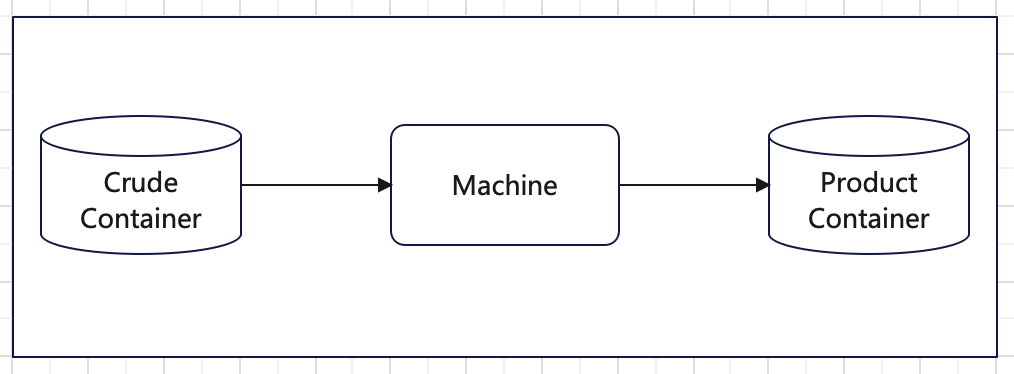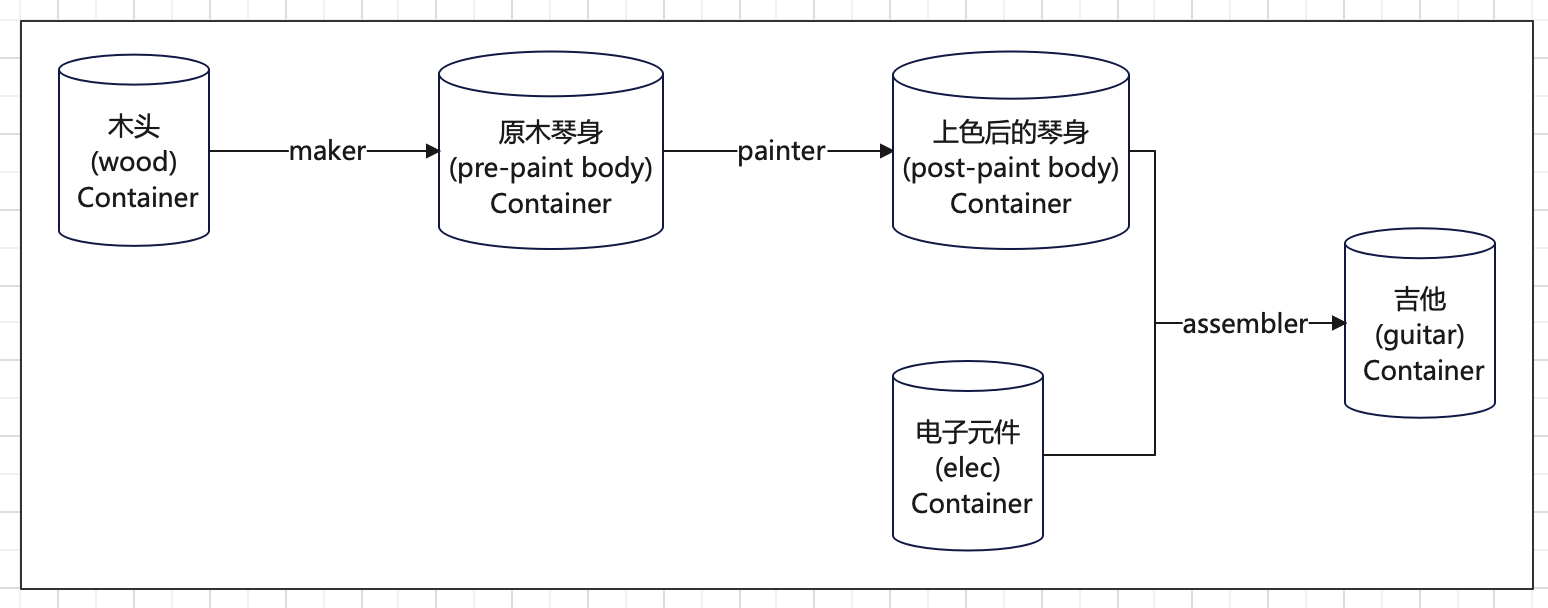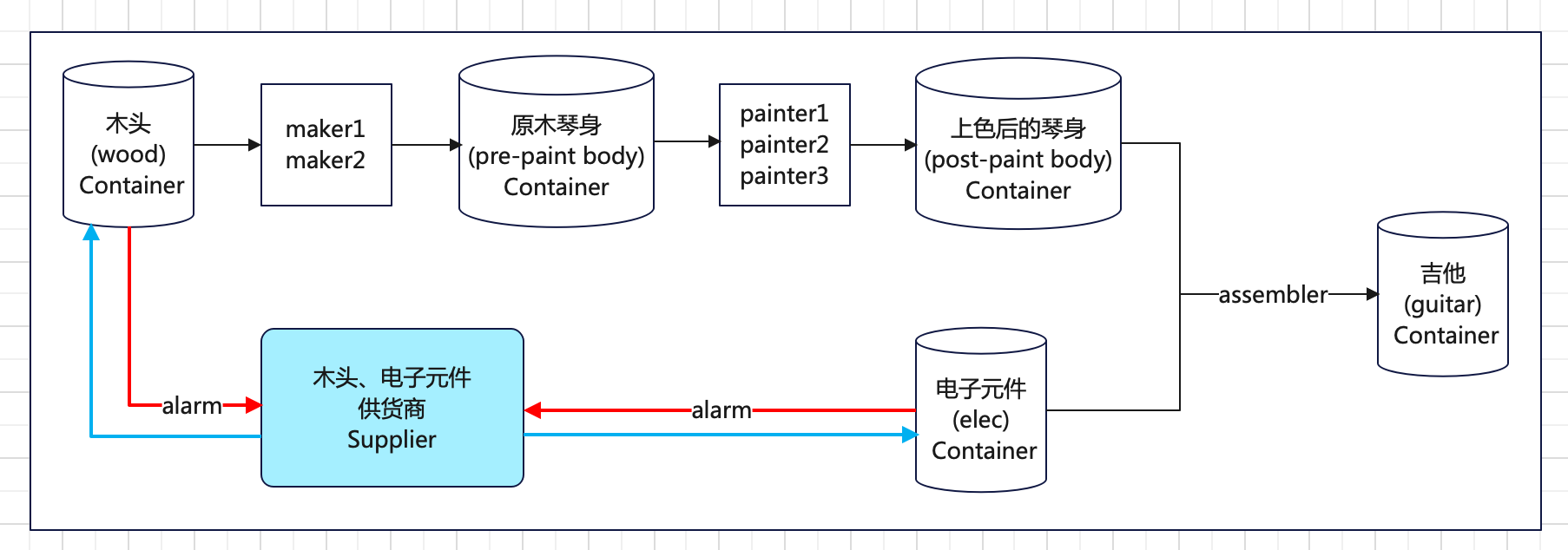import simpy
1. Components
1.1 Environment
核心中的核心,是用来承载一切模拟的环境
env = simpy.Environment() # 创建一个环境
proc1 = env.process(func) # 添加一个进程
1.2 Container
容器,用于存放物品
# 创建一个容量为 1000 的容器,初始容量为 500
Con1 = simpy.Container(env, capacity=1000, init = 500)
Con1.get(100) # 从容器中取出 100 个
print(Con1.level) # 查看容器中的剩余量 --> 400
Con1.put(200) # 向容器中放入 200 个
print(Con1.level) # 查看容器中的剩余量 --> 600
1.3 Resource
资源,可以用来表示机器、人员等。其特点在于一个资源同时只能被一个进程占用。因此更适用于表示流水线上的机器,或者是服务设施中的服务员:
- 汽车生产流水线上的机器
- 电影院中的售票员
# Create a workstation (with 3 parallel machines)
workstation = simpy.Resource(env, capacity=3)
# Request a machine from the workstation
with workstation.request() as req:
# Wait until one of the machines is available (如果三台机器都被占用,则会持续等待)
yield req
process_time = 1
# 执行机器操作
yield env.process(process_function())
Mutex-Lock
由于一个资源同时只能被一个进程占用的特性,我们可以直接拿它来作为 Mutex-Lock。例如,对于列表 reservation = [...],我们希望任意时刻最多只有一个函数能够修改它:
reservation = [...]
reservation_R = simpy.Resource(env, capacity=1)
def func_1(resv, resv_R):
with resv_R.request() as req:
# change resv here
pass
def func_2(resv, resv_R):
with resv_R.request() as req:
# change resv here
pass
更多信息可以参考 Simulating Dining Philosophers with SimPy
Alternatives
对于更传统的工厂 (reentrancy 较高,例如 fac), 或者那种更关注于流程而不是每个资源个体的, 可以使用如下代码来模拟 machine & workstation:
# Create a machine
def machine(env, con1, con2):
while True:
# get 2 inputs from Container_1
yield con1.get(2)
# after 1 time processing
yield env.timeout(1)
# put 1 output into Container_2
yield con2.put(1)
# Create a workstation (with 3 parallel machines)
def workstation(env, num_machines, con1, con2):
for i in range(3):
env.process(machine(env, con1, con2))
Example: Guitar Factory
吉他工厂: 使用木头和电子元件作为原材料,经过加工和组装后,生产出吉他。
.1 One Machine
最简单的工厂: 一台机器,使用一种原材料,生产一种产品。

# Containers
# crude container
crudeCon_capacity = 1000
crudeCon_initial = 500
# product container
prodCon_capacity = 500
#-------------------------------------------------
class Factory:
def __init__(self, env):
self.env = env
# 定义两个容器 (Container)
# 一个用来存放原材料,一个用来存放加工后的材料
self.crudeCon = simpy.Container(env, capacity=crudeCon_capacity, init = crudeCon_initial)
self.prodCon = simpy.Container(env ,capacity = prodCon_capacity, init = 0)
# 定义一台 machine
# [流程]: 从原料勇气中取出 2 个原材料,加工成 1 个产品,并放入产品容器
# [时间]: 1 个时间单位
def maker(self):
while True:
yield self.crudeCon.get(2)
process_time = 1
yield self.env.timeout(process_time)
yield self.prodCon.put(1)
#-------------------------------------------------
# 创建环境、工厂对象
env = simpy.Environment()
factory = Factory(env)
# 添加一台 machine
env.process(factory.maker())
# 模拟到第 50 个时间单位
env.run(until = 50)
print(f'%d products are finished!' % factory.prodCon.level)
Output: 250 products are finished!
.2 Parallel Machines (A Guitar Factory)

class Guitar_Factory:
def __init__(self, env):
self.env = env
# 定义五个容器 (Container)
self.woodCon = simpy.Container(env, capacity=1000, init = 500)
self.prePaintCon = simpy.Container(env, capacity=100, init = 0)
self.postPaintCon = simpy.Container(env, capacity=200, init = 0)
self.elecCon = simpy.Container(env, capacity=100, init = 100)
self.guitarCon = simpy.Container(env ,capacity=500, init = 0)
# 定义三台 machine
# maker: 加工木头,制作成琴身
def maker(self):
while True:
yield self.woodCon.get(2)
process_time = 1
yield self.env.timeout(process_time)
yield self.prePaintCon.put(1)
# painter: 为琴身涂漆
def painter(self):
while True:
yield self.prePaintCon.get(1)
process_time = 4
yield self.env.timeout(process_time)
yield self.postPaintCon.put(1)
# assembler: 组装琴身、电子元件,制作成吉他
def assembler(self):
while True:
yield self.postPaintCon.get(1)
yield self.elecCon.get(1)
process_time = 1
yield self.env.timeout(process_time)
yield self.guitarCon.put(1)
#-------------------------------------------------
# 创建环境、工厂对象
env = simpy.Environment()
factory = Guitar_Factory(env)
# 添加三台 machine
env.process(factory.maker())
env.process(factory.painter())
env.process(factory.assembler())
# 模拟到第 50 个时间单位
env.run(until = 50)
print(f'Pre-paint Container has %d bodies ready to be painted' % factory.prePaintCon.level)
print(f'Post-paint Container has %d bodies ready to be assembled' % factory.postPaintCon.level)
print(f'%d products are finished!' % factory.guitarCon.level)
.3 More Advanced
更加完整的吉他工厂:
- 加工时间服从正态分布
- workstation 中可以有多台 parallel machines
- 库存报警 + 订货: 当 wood or elec Containor 的库存量低于某个值时,触发报警装置,同时联系供应商订货

.3.1 Variable Processing Time
以 maker 为例,之前加工一个产品的时间为 1 个时间单位。现在假设加工时间服从正态分布 $N(1, 0.2)$。
def maker(self):
while True:
yield self.woodCon.get(2)
process_time = random.gauss(1, 0.2) # 调用 random 库
yield self.env.timeout(process_time)
yield self.prePaintCon.put(1)
.3.2 Multiple Machines in One Workstation
以 maker 为例,之前只有一个机器把木材加工为琴身。现在假设有两台并行的机器同时加工木材
num_maker = 2 # 两台机器
def makerGen(self): # maker Generator
for i in range(num_maker):
yield self.env.process(self.maker())
.3.3 Stock Alarm (库存报警装置)
以 woodCon 为例,当木材容器的库存量低于 100 时:
- 触发报警装置
- 同时联系木材供应商,购买 300 个木材 (leadtime = 16)
wood_critial_stock = 100
def wood_stock_control(self):
yield self.env.timeout(0)
while True:
if self.woodCon.level <= wood_critial_stock:
# 触发警报
print('Wood stock bellow critical level ({0}) at time {1}'.\
format(self.woodCon.level, int(self.env.now)))
# 联系供应商,购买 300 个木材
print('Calling wood supplier...')
yield self.env.timeout(16)
print('Wood supplier arrives at time {0}'.format(int(self.env.now)))
yield self.woodCon.put(300)
print('New wood stock is {0}'.format(self.woodCon.level))
# 进货一次之后,至少再等 8 个时间单位才能重新检查库存
yield self.env.timeout(8)
else:
# 如果没有触发警报,就每隔 1 个时间单位检查一次库存
yield self.env.timeout(1)
.3.4 完整代码
# Number of parallel machines
num_maker = 2
num_painter = 3
num_assembler = 1
# Critial Stock Level (when reach 触发警报并订货)
wood_critial_stock = 100
wood_order_amount = 300
wood_order_leadTime = 16
elec_critial_stock = 30
elec_order_amount = 50
elec_order_leadTime = 8
class Guitar_Factory:
def __init__(self, env):
self.env = env
# 五个容器 (Container)
self.woodCon = simpy.Container(env, capacity=1000, init = 500)
self.prePaintCon = simpy.Container(env, capacity=100, init = 0)
self.postPaintCon = simpy.Container(env, capacity=200, init = 0)
self.elecCon = simpy.Container(env, capacity=100, init = 100)
self.guitarCon = simpy.Container(env ,capacity=1000, init = 0)
# -----------------------------------------------------
# Machines
# maker: 加工木头,制作成琴身
def maker(self):
while True:
yield self.woodCon.get(2)
process_time = random.gauss(1, 0.2)
yield self.env.timeout(process_time)
yield self.prePaintCon.put(1)
# painter: 为琴身涂漆
def painter(self):
while True:
yield self.prePaintCon.get(1)
process_time = random.gauss(4, 1)
yield self.env.timeout(process_time)
yield self.postPaintCon.put(1)
# assembler: 组装琴身、电子元件,制作成吉他
def assembler(self):
while True:
yield self.postPaintCon.get(1)
yield self.elecCon.get(1)
process_time = 1
yield self.env.timeout(process_time)
yield self.guitarCon.put(1)
# -----------------------------------------------------
# Machine Generator: 生成多个 parallel machines
def makerGen(self): # maker Generator
for i in range(num_maker):
yield self.env.process(self.maker())
def painterGen(self): # painter Generator
for i in range(num_painter):
yield self.env.process(self.painter())
def assemblerGen(self): # assembler Generator
for i in range(num_assembler):
yield self.env.process(self.assembler())
# -----------------------------------------------------
# 定义库存报警
def wood_stock_control(self):
yield self.env.timeout(0)
while True:
if self.woodCon.level <= wood_critial_stock:
# 触发警报
print('Wood stock bellow critical level ({0}) at time {1}'.\
format(self.woodCon.level, int(self.env.now)))
# 联系供应商,购买 300 个木材
print('Calling wood supplier...')
yield self.env.timeout(wood_order_leadTime)
print('Wood supplier arrives at time {0}'.format(int(self.env.now)))
yield self.woodCon.put(wood_order_amount)
print('New wood stock is {0}'.format(self.woodCon.level))
print('------------------------------------------')
# 进货一次之后,至少再等 8 个时间单位才能重新检查库存
yield self.env.timeout(8)
else:
# 如果没有触发警报,就每隔 1 个时间单位检查一次库存
yield self.env.timeout(1)
def elec_stock_control(self):
yield self.env.timeout(0)
while True:
if self.elecCon.level <= elec_critial_stock:
print('Elec stock bellow critical level ({0}) at time {1}'.\
format(self.elecCon.level, int(self.env.now)))
print('Calling elec supplier...')
yield self.env.timeout(16)
print('Elec supplier arrives at time {0}'.format(int(self.env.now)))
yield self.elecCon.put(50)
print('New elec stock is {0}'.format(self.elecCon.level))
print('------------------------------------------')
yield self.env.timeout(8)
else:
yield self.env.timeout(1)
# 创建环境、工厂对象
env = simpy.Environment()
factory = Guitar_Factory(env)
# Add machines
env.process(factory.makerGen())
env.process(factory.painterGen())
env.process(factory.assemblerGen())
# Add alarm and replenishment
env.process(factory.wood_stock_control())
env.process(factory.elec_stock_control())
# Simulate to time 500
env.run(until = 500)
print(f'Pre-paint Container has %d bodies ready to be painted' % factory.prePaintCon.level)
print(f'Post-paint Container has %d bodies ready to be assembled' % factory.postPaintCon.level)
print(f'%d products are finished!' % factory.guitarCon.level)
Output:
Elec stock bellow critical level (30) at time 289
Calling elec supplier...
Elec supplier arrives at time 305
New elec stock is 77
------------------------------------------
Wood stock bellow critical level (100) at time 398
Calling wood supplier...
Wood supplier arrives at time 414
New wood stock is 394
------------------------------------------
Elec stock bellow critical level (30) at time 491
Calling elec supplier...
Pre-paint Container has 100 bodies ready to be painted
Post-paint Container has 0 bodies ready to be assembled
121 products are finished!
.4 Dispatch Production
我们还需要监测生产完成的吉他数量。如果库存量超过 50,就联系 retailor 来取货
def guitar_stock_control(self):
# 声明一个全局变量,来记录生产的吉他总数
global guitars_made
yield self.env.timeout(0)
while True:
if self.guitarCon.level >= 50:
print('Guitar Containor stock is {0}, calling store to pick guitars at time {1}'.format(self.guitarCon.level, int(env.now)))
yield env.timeout(4)
print('Store picking {0} guitars at day time {1}'.format(self.guitarCon.level, int(env.now)))
guitars_made += self.guitarCon.level
yield self.guitarCon.get(self.guitarCon.level)
print('----------------------------------')
yield env.timeout(8)
else:
yield env.timeout(1)
最后,把 stock alarm (control) 加入到 __init__ 函数中。完整代码如下:
# Number of parallel machines
num_maker = 2
num_painter = 3
num_assembler = 1
# Critial Stock Level (when reach 触发警报并订货)
wood_critial_stock = 100
wood_order_amount = 300
wood_order_leadTime = 16
elec_critial_stock = 30
elec_order_amount = 50
elec_order_leadTime = 8
class Guitar_Factory:
def __init__(self, env):
self.env = env
# 五个容器 (Container)
self.woodCon = simpy.Container(env, capacity=1000, init = 500)
self.woodControl = env.process(self.wood_stock_control())
self.elecCon = simpy.Container(env, capacity=100, init = 100)
self.elecControl = env.process(self.elec_stock_control())
self.prePaintCon = simpy.Container(env, capacity=100, init = 0)
self.postPaintCon = simpy.Container(env, capacity=200, init = 0)
self.guitarCon = simpy.Container(env ,capacity=1000, init = 0)
slef.guitarControl = env.process(self.guitar_stock_control())
# -----------------------------------------------------
# Machines
# maker: 加工木头,制作成琴身
def maker(self):
while True:
yield self.woodCon.get(2)
process_time = random.gauss(1, 0.2)
yield self.env.timeout(process_time)
yield self.prePaintCon.put(1)
# painter: 为琴身涂漆
def painter(self):
while True:
yield self.prePaintCon.get(1)
process_time = random.gauss(4, 1)
yield self.env.timeout(process_time)
yield self.postPaintCon.put(1)
# assembler: 组装琴身、电子元件,制作成吉他
def assembler(self):
while True:
yield self.postPaintCon.get(1)
yield self.elecCon.get(1)
process_time = 1
yield self.env.timeout(process_time)
yield self.guitarCon.put(1)
# -----------------------------------------------------
# Machine Generator: 生成多个 parallel machines
def makerGen(self): # maker Generator
for i in range(num_maker):
yield self.env.process(self.maker())
def painterGen(self): # painter Generator
for i in range(num_painter):
yield self.env.process(self.painter())
def assemblerGen(self): # assembler Generator
for i in range(num_assembler):
yield self.env.process(self.assembler())
# -----------------------------------------------------
# 定义库存报警
def wood_stock_control(self):
yield self.env.timeout(0)
while True:
if self.woodCon.level <= wood_critial_stock:
# 触发警报
print('Wood stock bellow critical level ({0}) at time {1}'.\
format(self.woodCon.level, int(self.env.now)))
# 联系供应商,购买 300 个木材
print('Calling wood supplier...')
yield self.env.timeout(wood_order_leadTime)
print('Wood supplier arrives at time {0}'.format(int(self.env.now)))
yield self.woodCon.put(wood_order_amount)
print('New wood stock is {0}'.format(self.woodCon.level))
print('------------------------------------------')
# 进货一次之后,至少再等 8 个时间单位才能重新检查库存
yield self.env.timeout(8)
else:
# 如果没有触发警报,就每隔 1 个时间单位检查一次库存
yield self.env.timeout(1)
def elec_stock_control(self):
yield self.env.timeout(0)
while True:
if self.elecCon.level <= elec_critial_stock:
print('Elec stock bellow critical level ({0}) at time {1}'.\
format(self.elecCon.level, int(self.env.now)))
print('Calling elec supplier...')
yield self.env.timeout(16)
print('Elec supplier arrives at time {0}'.format(int(self.env.now)))
yield self.elecCon.put(50)
print('New elec stock is {0}'.format(self.elecCon.level))
print('------------------------------------------')
yield self.env.timeout(8)
else:
yield self.env.timeout(1)
def guitar_stock_control(self):
# 声明一个全局变量,来记录生产的吉他总数
global guitars_made
yield self.env.timeout(0)
while True:
if self.guitarCon.level >= 50:
print('Guitar Containor stock is {0}, calling store to pick guitars at time {1}'.format(self.guitarCon.level, int(env.now)))
yield env.timeout(4)
print('Store picking {0} guitars at day time {1}'.format(self.guitarCon.level, int(env.now)))
guitars_made += self.guitarCon.level
yield self.guitarCon.get(self.guitarCon.level)
print('----------------------------------')
yield env.timeout(8)
else:
yield env.timeout(1)
# 创建环境、工厂对象
env = simpy.Environment()
factory = Guitar_Factory(env)
# Add machines
env.process(factory.makerGen())
env.process(factory.painterGen())
env.process(factory.assemblerGen())
# Add alarm and replenishment
env.process(factory.wood_stock_control())
env.process(factory.elec_stock_control())
# Simulate to time 500
env.run(until = 500)
print(f'%d products are produced!' % guitars_made)
SimPy + Tkinter
使用 Tkinter 实现一个简单的 GUI,用于控制 SimPy 模拟的过程以及实现流程的可视化。参考: https://towardsdatascience.com/simulating-real-life-events-in-python-with-simpy-619ffcdbf81f
.1 使用 Threading 避免 GUI 卡死
当 simulation 本身比较复杂时,可以使用 threading.Thread 为 GUI 创建一个独立的线程,减少卡顿
def tkinterGUI_main(name):
root = tk.Tk()
root.title(name)
root.geometry('800x600')
root.mainloop()
GUI = threading.Thread(target=tkinterGUI_main, args=('SimPy_GUI'))
GUI.start()
env.run(until = 500)
.2 SimPy + Tkinter.Toplevel
我们往往会希望在打开一个窗口时开始一个进程 env.process(),并且在关闭这个窗口时结束这个进程,从而避免资源浪费。这部分的内容详见 python-lib-tkinter#Toplvel#Toplevel + Tkinter
Document Information
- Author: Zeka Lee
- Link: https://zhekaili.github.io/wiki/python-libs/python-lib-SimPy/
- Copyright: 自由转载-非商用-非衍生-保持署名(创意共享3.0许可证)